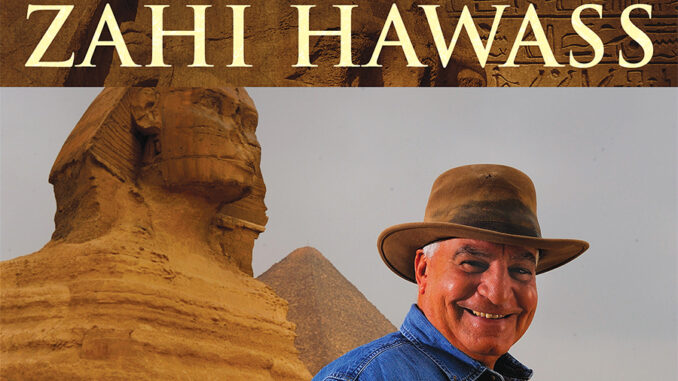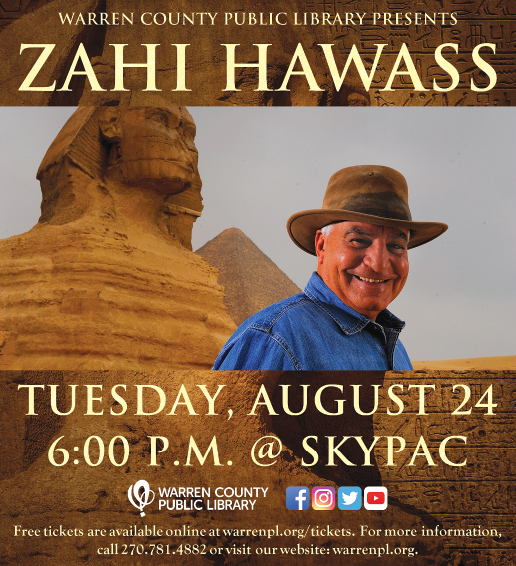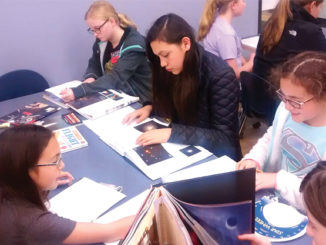
Warren County Public Library is delighted to welcome back Dr. Zahi Hawass. The world-renowned archaeologist will speak at the Southern Kentucky Performing Arts Center on Tuesday, August 24, at 6pm.
Dr. Hawass is the former Egyptian Minister of Antiquities and Director of Excavations at Giza, Saqqara, Bahariya Oasis, and the Valley of the Kings. Dr. Hawass’ impressive archaeological achievements are described on his website www.drhawass.com in this manner: “Dr. Hawass has made several major discoveries throughout his career, including the Tombs of the Pyramid Builders at Giza and the Valley of the Golden Mummies at Bahariya Oasis. He has discovered two previously unknown Old Kingdom pyramids, one near the Great Pyramid of Khufu at Giza and one belonging to a queen of King Teti at Saqqara. Also, at Saqqara, he rediscovered the pyramid of the 6th Dynasty queen Khuit, along with another pyramid which he has determined… belonged to a 5th Dynasty queen. Dr. Hawass has been involved in several other important archaeological projects. He led the search for the tomb of Cleopatra and Mark Antony on the premises of a Ptolemaic temple near Alexandria. He enriched the search for the so-called ‘hidden doors’ inside the Great Pyramid. In addition, Dr. Hawass launched a new excavation under the Nile River’s waters, searching for missing obelisks and statues.”
Zahi Hawass was born in a small village near Damietta, Egypt. This port city is located in the Nile River Delta in northeastern Egypt near the Mediterranean Sea. In 1967, Hawass received a Bachelor of Arts degree from the Alexandria University in Alexandria, Egypt. He obtained a diploma in Egyptology from the Cairo University in 1979 and became an inspector – a combination of administrator and archaeologist – at the Great Pyramids.
When Zahi was 33 years old, he was awarded a Fulbright Fellowship to attend the University of Pennsylvania in Philadelphia to study Egyptology. There he earned a Master of Arts degree in Egyptology and Syro-Palestinian Archaeology in 1983. His Ph.D. in Egyptology in 1987 came from the Graduate Group in the Art and Archaeology of the Mediterranean World (AAMW), concentrating on “The Funerary Establishments of Khufu, Khafra and Menkaura During the Old Kingdom.”
In Dr. Hawass’ archaeology and early political careers, he was the Associate Director of Excavation at Hermopolis in 1968. He was the Inspector of Antiquities from 1969 to 1975, which included the Yale expedition at Abydos, Egypt, in 1969 and the Abu Simbel between 1972 and 1974. Hawass was also the Associate Director of Excavation at Tarrana from 1970 to 1974. He has taught Egyptian archaeology, culture, and history in Egypt and the United States.
Hawass has been the Excavation Director and Restoration director at various sites throughout Egypt, predominantly Giza, since 1975. He has been the Director-General of the Giza Monuments since 1989. In 1998, he was promoted to the position of Undersecretary of the State of Giza Monuments and continued to be involved in archaeological sites at Giza and around Egypt.
In 1990, Dr. Hawass discovered a necropolis that housed the tombs of the pyramid builders in Giza. Dr. Hawass also started the excavation of an extensive collection of tombs near Bahariya Oasis. According to the Britannica online encyclopedia, “The site became known as the Valley of the Golden Mummies after the tombs’ well-preserved denizens, the most that had ever been found at a single site.”
During the early 2000s, Dr. Hawass continued working in the archeological field and the Egyptian government. His extensive book publications include King Tutankhamun: the Treasures of the Tomb; Mountains of the Pharoahs: the Untold Stories of the Pyramid Builders; and Secrets from the Sand: My Search for Egypt’s Past, all of which are available for check-out from Warren County Public Library. Dr. Hawass continues this work today.
Dr. Hawass is also involved in the ScanPyramid project, where scientists are using infrared thermography and muon tomography to search for crevices and voids in the pyramids. The ScanPyramid project started in October of 2015. The scientists use non-invasive and non-destructive techniques so they can have a better understanding of how the pyramids are constructed. In 2017, they found a large void in the Great Pyramid that was the size of a plane. Another void was discovered in 2019, also in the Great Pyramid. Dr. Hawass believes that the discovery of these voids increases the possibility that scientists may still find the body of Pharaoh Khufu, who had the Great Pyramid built. Scientists suspected that there were voids in the pyramids but had not been able to prove it until the ScanPyramid project’s discovery. The project is still ongoing, and Dr. Hawass has said they hope to find many more great discoveries.
Last year, archaeologists discovered a well-preserved “lost city” while looking for the mortuary temple of boy King Tutankhamun. We look forward to hearing about the “lost city” during Dr. Hawass’ presentation on August 24.
-submitted by Warren County Public Library





